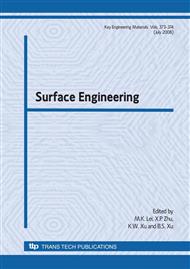p.130
p.134
p.138
p.142
p.146
p.151
p.155
p.159
p.163
The Preparation and Properties of TiN/Carbon Coatings by Ion Beam Assistant Magnetron Spurting Deposition
Abstract:
TiN/carbon multilayer coatings were deposited on M2 and GCr15 wafers by ion beam assistant magnetron spurting deposition (IBMSD). The hardness, elastic modulus, fracture toughness, adhesion strength and tribological properties were investigated. The results show that TiN coating by means of static recoil N+ doped interface preparation and Ar+ beam assistant magnetron spurting has 2 times adhesion strength, 5 times hardness of none-beam-assistant TiN coating. The wear rate of GCr15 wafer with TiN(2h)/Carbon(4h) multilayer coating is 0.36×10-15m3/Nm,1/5 of that of GC15 wafer without coating. The wear rate of M2 wafer with TiN(2h)/Carbon(4h) multilayer coating is 2.8×10-15m3/Nm, 1/8 of that of M2 wafer without coating. The friction coefficient of GCr15 wafter with TiN(2h)/Carbon(4h) multilayer coating is lower than 0.15, and that is 0.04 for M2 wafer. These results indicate that thickness ratio of TiN to carbon is important for the tribological properties of TiN/carbon coating, thick lubricant carbon/thin load-support TiN multilayer coating has better comprehensive tribological properties.
Info:
Periodical:
Pages:
146-150
Citation:
Online since:
March 2008
Price:
Сopyright:
© 2008 Trans Tech Publications Ltd. All Rights Reserved
Share:
Citation:


